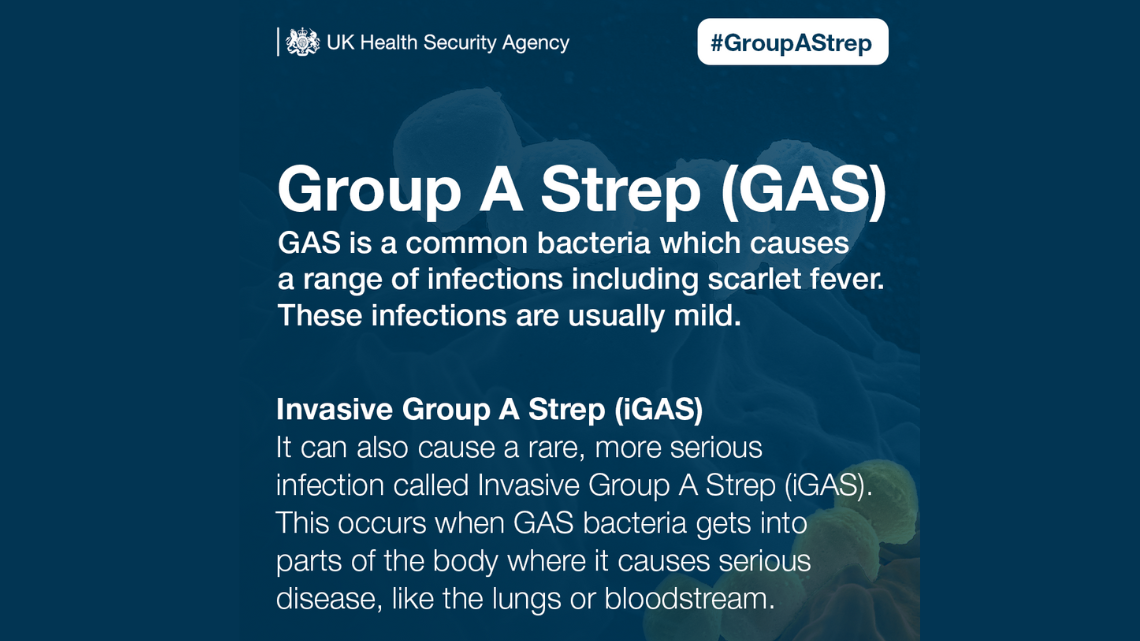
We have identified a small number of our patients who have developed an infection called invasive Group A Streptococcus (also known as invasive Strep A). This page gives some more information and general advice about this infection.
Group A streptococcus (GAS)
Group A streptococcus (GAS) – also known as Streptococcus pyogenes – are bacteria that can be found in the throat and on the skin. People may carry GAS and have no symptoms of illness or may develop infection.
How GAS is spread
Streptococcus bacteria survive in throats and on skin for long enough to allow easy spread between people through sneezing and skin contact. People who are currently carrying GAS in the throat or on the skin with no symptoms of illness are described as colonised. Both individuals who are colonised with GAS or who are unwell with a GAS infection can pass these bacteria on to others.
Kinds of illnesses caused by GAS
Most GAS illnesses are relatively mild such as ‘strep throat’, scarlet fever or a skin infection such as impetigo. However, on rare occasions, these bacteria can cause other severe and even life-threatening diseases.
Invasive group A streptococcal (iGAS) disease
Although rare, life-threatening GAS disease may occur when bacteria get into parts of the body where bacteria usually are not found, such as the blood or muscle. These infections are called invasive group A streptococcal (iGAS) disease. Two of the most severe, but rare, forms of iGAS disease are necrotising fasciitis and streptococcal toxic shock syndrome. Necrotising fasciitis destroys muscles, fat, and skin tissue. Streptococcal toxic shock syndrome causes blood pressure to drop rapidly and organs (for example, kidney, liver, lungs) to fail.
Why iGAS disease occurs
iGAS infections occur when the bacteria get past the defences of the person who is infected. This may occur when a person has sores or other breaks in the skin that allow the bacteria to get into the tissue, or when the person’s ability to fight off the infection is decreased because of chronic illness or an illness that affects the immune system. Although healthy people can get iGAS disease, people with chronic illnesses (such as cancer, diabetes, heart disease), and individuals who are pregnant or have recently given birth, have a higher risk.
How common is iGAS?
iGAS disease is rare; however there has been a national increase in cases of this disease this winter. There are usually 2 to 4 cases per 100,000 population annually.
Risk of getting iGAS disease from close contact with a relative or household contact
Most people who come into contact with GAS remain well and symptom-free, or develop mild throat or skin infections. Healthy people can get iGAS disease from a relative or a member of their household who has been ill or is colonised with GAS but it is very rare.
Whether contacts of a case require treatment
Contacts of an iGAS case do not usually require any treatment, and it is rare for contacts to develop symptoms. However, some household contacts may be offered antibiotics if they are elderly (75 years or older), pregnant (≥37 weeks), within 28 days of giving birth, a newborn baby (under 1 month), or have chickenpox. If someone else in the household experiences any symptoms of a GAS infection such as sore throat, skin infection or fever within 30 days of the first case, they should also contact their doctor promptly, and may require antibiotics.
What do I need to be aware of?
The most important thing to be aware of are the early signs and symptoms of iGAS disease which are shown below.
Early signs and symptoms of invasive group A streptococcal (iGAS) disease
Early symptoms include:
- high fever
- severe muscle aches
- localised muscle tenderness
- increasing pain, swelling and redness at site of wound
- unexplained diarrhoea or vomiting.
What to do if I develop any of these symptoms
If you develop any of these symptoms, you should seek medical advice immediately from your GP or NHS 111, or attend your local A&E. It is very likely that the doctor will ask you to come into the surgery so they can examine you. The UKHSA guidance on group A streptococcal disease in contacts is available for your doctor online.
Good infection control measures such as effective hand hygiene, good general cleaning and careful handling of soiled household linens such as bedding, and towels reduce the risk of cross infection.
Most people who come into contact with GAS remain well and symptom-free or develop mild throat or skin infections. Contracting iGAS disease from a household member is very rare.


